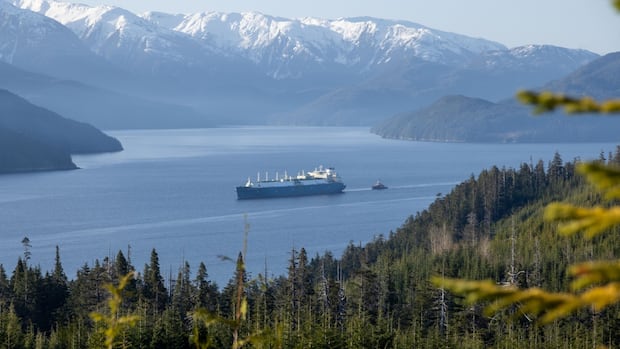[
LNG Canada has started producing liquefied natural gas for export at its facility in Kitimat, B.C., about 650 kilometres northwest of Vancouver.
A spokesperson confirmed Sunday the company has “safely achieved its first production” of LNG.
The West Coast plant will receive natural gas, transported via the Coastal GasLink pipeline from near Dawson Creek in the province’s northeast, cool it, and ship it to Asian markets.
The facility is the first large-scale Canadian LNG project to begin production and also the first major LNG facility in North America with direct access to the Pacific coast, significantly reducing sail time to Asian markets when compared to U.S. Gulf Coast facilities.
It is expected to export 14 million tonnes of LNG a year, creating close to 300 ongoing jobs at an estimated value of $575 million annually for 40 years, according to the B.C. government. A proposed Phase 2 would increase the export amount to 28 million tonnes annually.
Costing $40 billion, the Canadian government has said the project is the “largest single private sector investment in the history of the country,” with backing from Shell, Petronas, PetroChina, Mitsubishi Corporation and the Korea Gas Corp.
Daybreak North7:18LNG Canada set to make its first shipment
Partners still considering phase 2 of the project
Kitimat Mayor Phil Germouth said LNG Canada is an example other major infrastructure builders should follow.
“They clearly set a gold standard when it comes to getting communities on side, getting First Nations on side,” Germouth told CBC’s chief political correspondent Rosemary Barton.
“They’ve done a fantastic job of that.”
LNG Canada says it is on track to load first cargoes by the middle of 2025.
What is LNG?
LNG is made from natural gas, a fossil fuel often extracted from northeast B.C. and Alberta through a practice called hydraulic fracturing, or fracking.
It involves drilling down into the ground and injecting a mixture of water, sand and chemicals into the ground to force the release of the oil and gas.
The gas is then shipped via pipeline to terminals, which cool it to about –160 C, at which point it can be shipped overseas for use as a fuel.
LNG is often referred to as “clean” because burning it for fuel causes fewer emissions than coal or oil, but that claim is disputed by some analysts because of the energy and destruction it takes to produce.
One of the known impacts of fracking is an increase in earthquakes, which have been felt with increasing frequency in B.C.’s Peace River region in recent years.
Two other smaller LNG export facilities are also under construction in B.C.
The facilities, Woodfibre LNG (near Squamish) and Cedar LNG (in Kitimat), are expected to be completed between 2027 and 2028.
